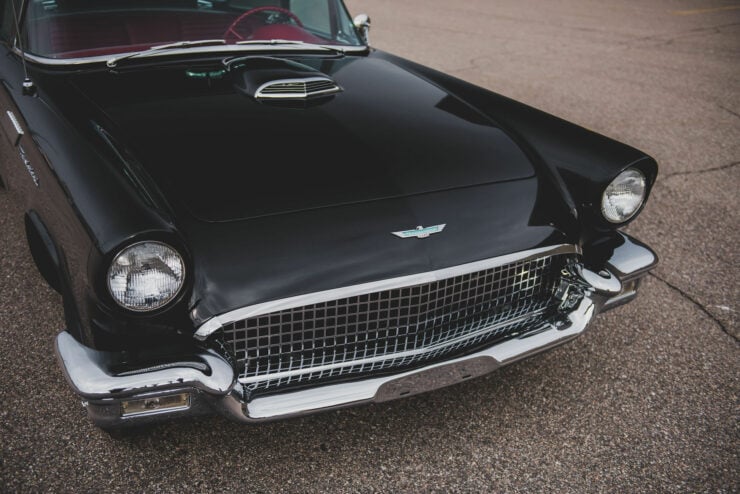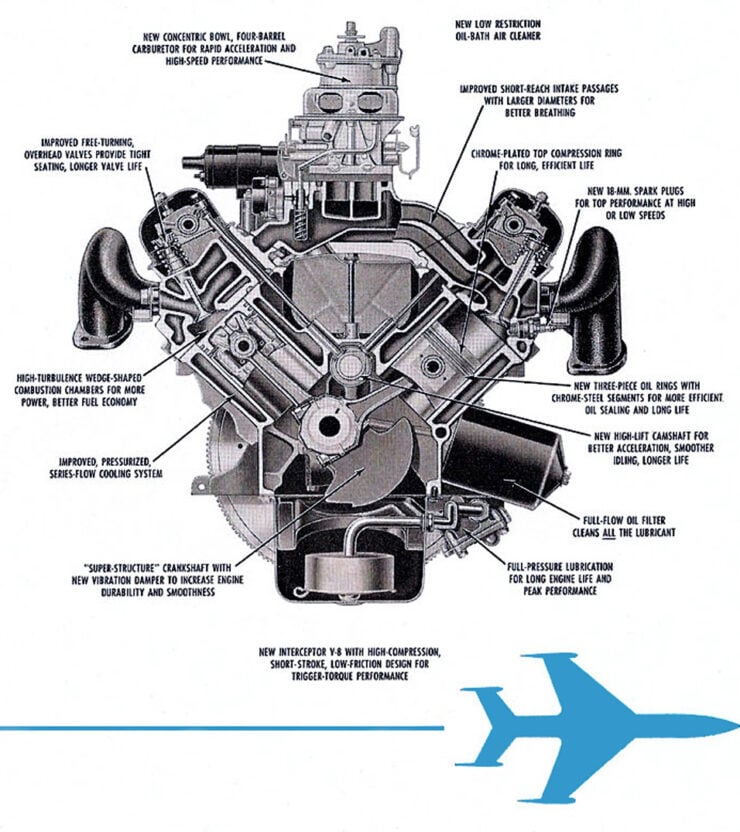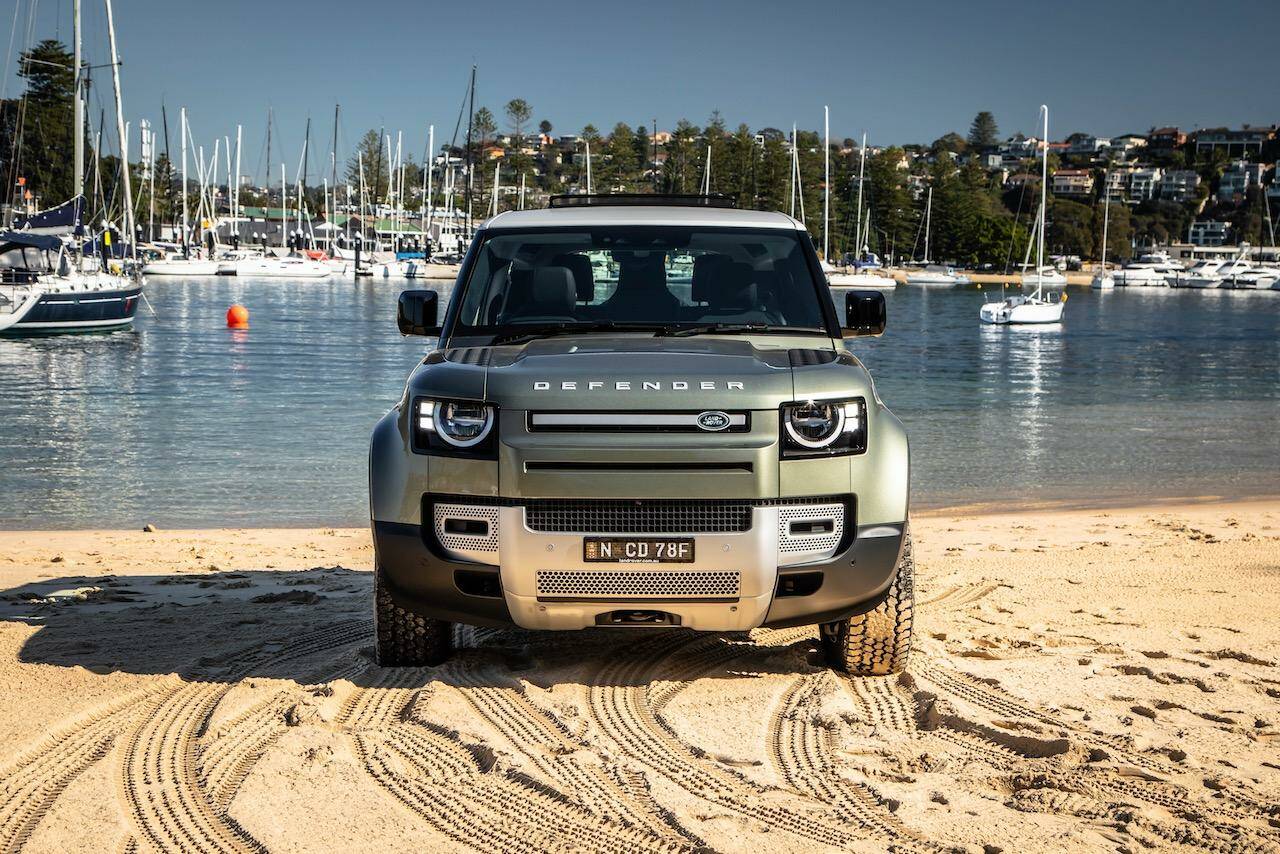A Rare Factory-Supercharged Ford Thunderbird “F-Code” Is For Sale

The Ford Thunderbird “F-Code” is undeniably the most desirable of the first generation production Thunderbirds. Externally they look much like their naturally-aspirated stablemates but once you look under the hood you can’t miss the hefty McCulloch/Paxton centrifugal supercharger.
Just 212 examples of the F-Code Thunderbird were made, largely due to the significant additional cost, but Ford hadn’t developed the high-performance version in the hopes of selling them hand over fist – they were developed to homologate the supercharged version for NASCAR competition.
Fast Facts – The Ford Thunderbird “F-Code”
- The first generation Ford Thunderbird was introduced in the 1955 model year and sold until 1957. It was a direct answer to the Chevrolet Corvette that had appeared in 1953, and to an extent it was also aimed at competing with the onslaught of successful sports cars pouring into the United States from England.
- The engineering that went into the Thunderbird was standard for the time, with drum brakes front and rear, body-on-chassis construction, independent front suspension, a live axle rear, and a front-mounted V8 sending power back through either a manual or automatic gearbox.
- The styling of the Thunderbird was pure Jet Age, in fact the car is often used now as an example of Jet Age automotive design, with all the fins, chrome, and aircraft inspired styling you could possibly want.
- The Ford Thunderbird F-Code was released in 1957, it was powered by the high-performance 312 cubic inch Ford V8 which had a McCulloch/Paxtoncentrifugal supercharger fitted. Power was increased from 245 bhp to 300+ bhp.
Building A Corvette Killer
When the Chevrolet Corvette was first shown to the public at the Waldorf-Astoria Hotel in New York in 1953 it sent a shockwave through the American automotive world. Here at last was a homegrown car that promised all of the performance of the lightning-fast European sports cars that had been pouring into the USA after WWII.


Ford executives quickly realized they needed an answer to the new Chevrolet, it needed to be every bit as stylish but faster and with more focus on luxury. That same year the Ford Vega concept car had been shown, with sleek styling influenced by the Jaguar XK120, but it wasn’t approved for production – instead an all new car was developed.
Ford Designer Bill Boyer was the lead stylist on the first Ford Thunderbird slated for 1955, and he was joined by Lewis Crusoe, George Walker, Frank Hershey, and Bill Burnett. As a team they created one of the most enduring Ford designs of all time, and certainly one of the most memorable of the age.
The specifications of the original 1953 Corvette weren’t as impressive as the car’s looks. It was fitted with the 3.9 liter Blue Flame inline-six cylinder engine making 150 bhp and surprisingly it could only be ordered with a 2-speed Powerglide automatic transmission – as Chevrolet didn’t have a suitable manual gearbox at the time.
This engine and transmission combination resulted in relatively poor performance, and the 2-speed automatic transmission made the car all but unusable in motorsport. These early Corvettes were a sheep in wolf’s clothing so to speak, and they left the door open for Ford to release a considerably faster car and steal the Corvette’s lunch money.


The Ford Thunderbird Arrives
The team behind the Thunderbird developed the new car rapidly, it went from an idea to a physical concept car in just a year and it was shown at the Detroit Auto Show in February of 1954. Amazingly the first production cars were delivered starting in September of that same year, as 1955 model year vehicles.
This rapid development schedule meant that Ford engineers needed to use tried and tested technologies in the design rather than attempting to reinvent the wheel. So the Thunderbird was given independent front suspension on coils, a live axle rear on leaf springs, drum brakes on all four corners, and a front-mounted V8 sending power back through either a manual or automatic transmission.
The frame was a shortened version of a chassis used on other production Fords, and the “Interceptor” 292 cubic inch (4.8 liter) Y-block Ford V8 engine from the Mercury division was fitted. This engine was mated to either a 3-speed manual transmission or a Fordomatic automatic 3-speed.


Each Thunderbird was shipped to owners with fender skirts and a removable lightweight fiberglass top, though a folding fabric convertible top as a commonly specified option – it was easy to get caught out by the weather when driving the car with the hardtop off after all.
Ford didn’t market the Thunderbird as a sports car, but rather as a luxury tourer. Essentially an American answer to the GTs or “Grand Tourers” coming out of Europe. A number of luxury and safety features were included, like pushbutton interior door handles, four-way powered seats, and a telescoping steering wheel – though there was a tachometer for the more sporting drivers.
The first generation Thunderbird was sold for three years and cars from each of the years are instantly distinguishable from one another. The 1955 was the first model year and featured a shorter rear end with the spare tire in the trunk – though this didn’t leave much room for luggage.
The 1956 model had the spare moved into a spare tire carrier on the rear of the car, this increased trunk space but it moved the weight of the wheel right to the back of the car and some felt that it upset handling.


In 1957 the spare was placed back in the trunk but the rear end of the car was lengthened noticeably, so that there was ample space in the trunk for the spare and a reasonable amount of luggage.
1957 would also see the release of the F-Code Thunderbird, a special version fitted with the high-performance 312 cubic inch V8 and a McCulloch/Paxton centrifugal supercharger that boosted power to 300+ bhp at 4,800 rpm with 439 lb ft of torque at 2,600 rpm.
These F-Code cars were built to homologate the Thunderbird for NASCAR and they cost a pretty penny, increasing the price of the car by 13% depending on the options chosen.
The amount of power and torque they generated was arguably too much for the chassis, suspension, or brakes – but owners could make light work of almost any other production car on the road in red light drag races and sometimes that all that really matters.


The second generation Thunderbird would debut for the 1958 model year. It was an altogether different car that had a second row of seats, considerably more trunk space, a longer wheelbase, and a markedly increased curb weight.
Any semblance of sporting driving was now gone, but the car proved to be a major sales success, and it vastly outsold the Corvette.
Ford Thunderbird F-Code Specifications
- The Ford Thunderbird F-Code was released in 1957 and sold for one year only, to homologate the model for NASCAR racing.
- Under the hood of the F-Code you would find a high-performance 312 cubic inch Y-block V8 fitted with a McCulloch/Paxton centrifugal supercharger. This optional extra could be ordered with either the automatic or manual transmission.
- Power output of the 312 V8 was considerably increased, climbing to 300+ bhp at 4,800 rpm with 439 lb ft of torque at 2,600 rpm, up from 245 bhp on the non-forced induction engine.
- The fifteen competition Thunderbird F-Codes that were initially built by Ford raced at the Daytona Beach Speed Trials in 1957.
- One of these cars, known as the Phase 1 Thunderbirds, set a new record for an American sports car – with a speed of 138.755 mph, this was a 6 mph improvement over the 1956 record which had been set by Corvette.
- There is some debate about how many F-Code Thunderbirds were actually made, some say 196, some say 200, or 205, but the most widely used number is 212.


The 1957 Ford Thunderbird F-Code Shown Here
The car you see here is one of the original batch of homologation 1957 Ford Thunderbird F-Code cars, finished in the popular color combination of Raven Black with Flame red pleated vinyl upholstery.
This car was delivered new to Fortner Motor Company of Los Angeles, it was ordered without the soft top but it came with a matching Raven Black, and the more sporting gearbox choice – the 3-speed manual transmission with overdrive.
A number of notable F-Code enthusiasts have previously owned this car including Jim Weatherly, Robert “Bo” Cheadle, and Amos Minter. It’s now being offered for sale in excellent overall condition however it’s been kept in climate-controlled storage for the past decade and will require a thorough servicing and some fresh tires before any driving is undertaken.
If you’d like to read more about it or register to bid you can visit the listing here on RM Sotheby’s, it’s due to roll across the auction with them on the 4th of March at their Amelia Island auction.











Images: Darin Schnabel ©2022 Courtesy of RM Sotheby’s + The Ford Motor Company

Articles that Ben has written have been covered on CNN, Popular Mechanics, Smithsonian Magazine, Road & Track Magazine, the official Pinterest blog, the official eBay Motors blog, BuzzFeed, Autoweek Magazine, Wired Magazine, Autoblog, Gear Patrol, Jalopnik, The Verge, and many more.
Silodrome was founded by Ben back in 2010, in the years since the site has grown to become a world leader in the alternative and vintage motoring sector, with well over a million monthly readers from around the world and many hundreds of thousands of followers on social media.





